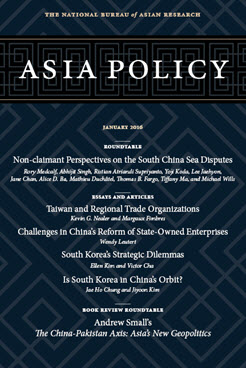Out of Its Comfort Zone
Indonesia and the South China Sea
This essay is part of the roundtable “Non-claimant Perspectives on the South China Sea Disputes.”
During a visit to Tokyo in 2015, Indonesia’s president Joko Widodo publicly rejected China’s so-called nine-dash or U-shaped line claim in the South China Sea. Yet shortly thereafter in Beijing, he also agreed with Chinese president Xi Jinping that Indonesia’s “global maritime fulcrum” (poros maritim dunia) concept is complementary to China’s 21st Century Maritime Silk Road. [1] Widodo’s statements give the impression that Indonesia is conveying a conflicting message to China, expressing concern about the U-shaped line while simultaneously trying to cultivate a closer economic relationship through maritime cooperation. This approach appears to reflect a hedging strategy that Indonesia and other Southeast Asian nations take in both accommodating and confronting China’s rise at the same time. [2] In the long run, however, Indonesia could face a fork in the road where it will be unable to have closer cooperation with China while concurrently resisting intimidation and coercion whenever and wherever China attempts to impose the U-shaped line.
This essay examines Indonesia’s perspective as a non-claimant state on the South China Sea disputes. The first section discusses Indonesia’s interests in the South China Sea. The essay then considers the relevance of Indonesia’s status as a non-claimant state for its role in the disputes and assesses the implications of the South China Sea disputes for Indonesia’s relationships with China and the United States. Finally, the conclusion discusses the future that Indonesia envisages for the South China Sea.
What Is at Stake?
The territorial disputes in the South China Sea place Indonesia’s interests at stake, namely the security of the resource-rich Natuna Islands, the sanctity of the United Nations Convention on the Law of the Sea (UNCLOS), the security of sea lines of communication, and nonalignment vis-á-vis the major powers. The security of the Natuna Islands is Indonesia’s immediate concern in the South China Sea. China has never claimed the islands, yet neither has it clarified to Indonesian policymakers the meaning of the U-shaped line. Indonesia rejects the U-shaped line and claims to have neither territorial nor boundary disputes with China. [3] However, Indonesia is increasingly concerned with the potential spillover effects of conflict between China and other claimants as a result of Beijing’s assertive enforcement of the U-shaped line.
The Natuna Islands are scattered across over 100,000 square miles of ocean—more than ten times the size of their total land area—and only 27 out of the 154 islands are inhabited, with a total population of around 76,000 people. [4] Despite the lack of infrastructure, the Natuna Islands are one of Indonesia’s richest regencies in offshore natural resources. Fisheries are estimated to yield a potential of 500,000 tons annually, but in reality the locals manage to haul in only a third of it through traditional methods. Chinese fishermen continually venture south into the fishing grounds around the islands, escorted by Chinese government fishery patrol vessels. A number of incidents have occurred between these vessels and Indonesian maritime authorities while the latter were trying to apprehend illegal Chinese fishermen, including one threatening encounter in which a Chinese government vessel trained its guns on an Indonesian patrol boat. [5]
Beneath the seabed also lie vast energy resources. Located within the purported overlap of the U-shaped line, the East Natuna block (block D-Alpha) is estimated to contain one of the world’s largest gas reserves at around 46 trillion cubic feet. Indonesia’s oil and gas company, Pertamina, in partnerships with U.S.-based ExxonMobil, France’s Total SA…
Endnotes
[1] Kanupriya Kapoor and Linda Sieg, “Indonesian President Says China’s Main Claim in South China Sea Has No Legal Basis,” Reuters, March 23, 2015, http://www.reuters.com/article/us-indonesia-china-southchinasea-idUSKBN0MJ04320150323; and “Joint Statement on Strengthening Comprehensive Strategic Partnership between the People’s Republic of China and the Republic of Indonesia,” Ministry of Foreign Affairs of the People’s Republic of China, March 26, 2015, http://www.fmprc.gov.cn/mfa_eng/wjdt_665385/2649_665393/t1249201.shtml.
[2] Cheng-Chwee Kuik, “Malaysia’s Balancing Act,” New York Times, December 6, 2015, http://www.nytimes.com/2015/12/07/opinion/malaysias-balancing-act.html.
[3] Randy Faby and Ben Blanchard, “Indonesia Asks China to Clarify South China Sea Claims,” Reuters, November 12, 2015, http://www.reuters.com/article/us-southchinasea-china-indonesia-idUSKCN0T10KK20151112#FpxvFikQ4V2vr8eB.97.
[4] Ristian Atriandi Supriyanto, “Indonesia’s Natuna Islands: Next Flashpoint in the South China Sea?” S. Rajaratnam School of International Studies (RSIS), RSIS Commentary, no. 033, February 16, 2015, https://www.rsis.edu.sg/wp-content/uploads/2015/02/CO15033.pdf
[5] Scott Bentley, “Shaping the Narrative: New Chinese Documentary Revisits Indonesia and the South China Sea,” Australian Strategic Policy Institute, Strategist, February 26, 2014, http://www.aspistrategist.org.au/shaping-the-narrative-new-chinese-documentary-revisits-indonesia-and-the-south-china-sea.
Ristian Atriandi Supriyanto is an Indonesian Presidential PhD Scholar with the Strategic and Defence Studies Centre at the Australian National University.
About Asia Policy
Asia Policy is a peer-reviewed scholarly journal presenting policy-relevant academic research on the Asia-Pacific that draws clear and concise conclusions useful to today’s policymakers. Asia Policy is published quarterly in January, April, July, and October and accepts submissions on a rolling basis. Learn more


